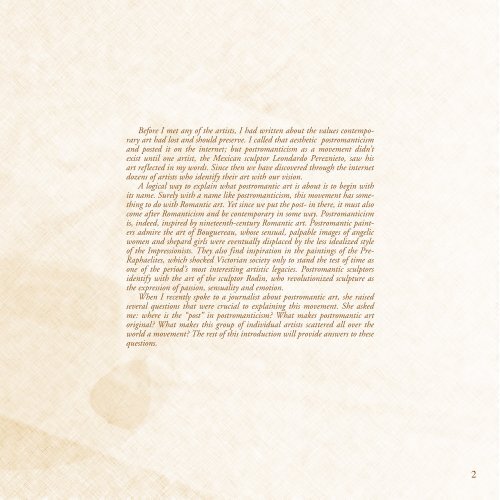Postromanticism The Art of Passion - Claudia Moscovici
Postromanticism The Art of Passion - Claudia Moscovici
Postromanticism The Art of Passion - Claudia Moscovici
You also want an ePaper? Increase the reach of your titles
YUMPU automatically turns print PDFs into web optimized ePapers that Google loves.
Before I met any <strong>of</strong> the artists, I had written about the values contemporary<br />
art had lost and should preserve. I called that aesthetic postromanticism<br />
and posted it on the internet; but postromanticism as a movement didn’t<br />
exist until one artist, the Mexican sculptor Leondardo Pereznieto, saw his<br />
art reflected in my words. Since then we have discovered through the internet<br />
dozens <strong>of</strong> artists who identify their art with our vision.<br />
A logical way to explain what postromantic art is about is to begin with<br />
its name. Surely with a name like postromanticism, this movement has something<br />
to do with Romantic art. Yet since we put the post- in there, it must also<br />
come after Romanticism and be contemporary in some way. <strong>Postromanticism</strong><br />
is, indeed, inspired by nineteenth-century Romantic art. Postromantic painters<br />
admire the art <strong>of</strong> Bouguereau, whose sensual, palpable images <strong>of</strong> angelic<br />
women and shepard girls were eventually displaced by the less idealized style<br />
<strong>of</strong> the Impressionists. <strong>The</strong>y also find inspiration in the paintings <strong>of</strong> the Pre-<br />
Raphaelites, which shocked Victorian society only to stand the test <strong>of</strong> time as<br />
one <strong>of</strong> the period’s most interesting artistic legacies. Postromantic sculptors<br />
identify with the art <strong>of</strong> the sculptor Rodin, who revolutionized sculpture as<br />
the expression <strong>of</strong> passion, sensuality and emotion.<br />
When I recently spoke to a journalist about postromantic art, she raised<br />
several questions that were crucial to explaining this movement. She asked<br />
me: where is the “post” in postromanticism? What makes postromantic art<br />
original? What makes this group <strong>of</strong> individual artists scattered all over the<br />
world a movement? <strong>The</strong> rest <strong>of</strong> this introduction will provide answers to these<br />
questions.<br />
2


